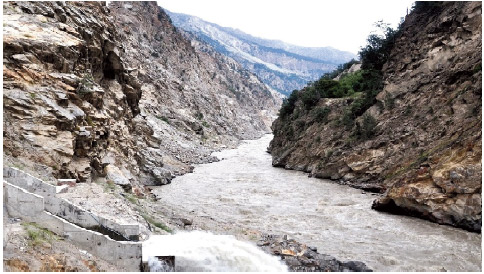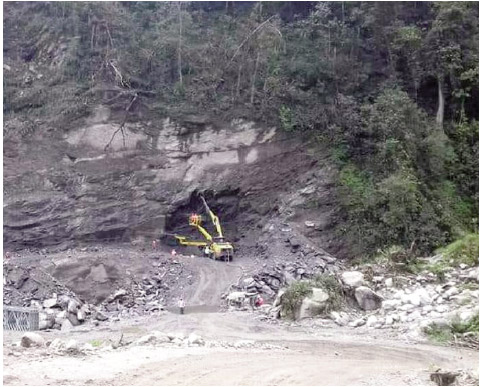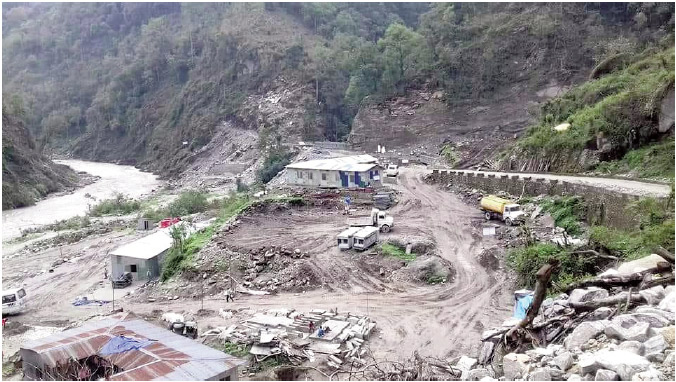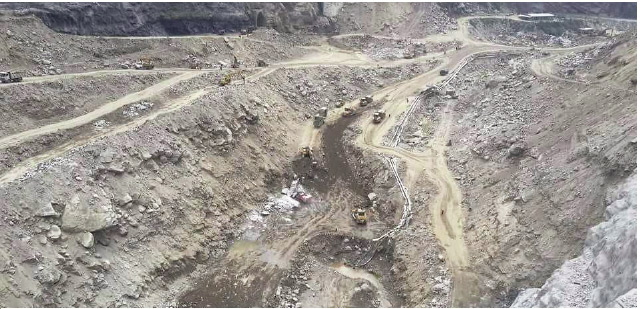New norms irrational
 Rakesh Lohumi
Rakesh Lohumi
 A view of outfall of a small project on a river
tributory
The decision of the government to relax norms for
small hydropower projects will have serious
consequences for environment in the ecologically
fragile Himalayan region where a large number of
projects are in the pipeline. Under the revised
norms, projects up to 25 MW capacity will not be
required to obtain the “Consent to Operate” anymore and just
an intimation to the State Pollution Control Board (SPCB) will be
enough to start work. This effectively dismantles the
mechanism provided for addressing environmental concerns
and monitoring the implementation of projects. The SPCB will
have no role and it will no longer be in a position to enforce
environmental laws. Hydropower projects do not cause air or
water pollution as such but they have huge environmental and
socioeconomic fallout.
A view of outfall of a small project on a river
tributory
The decision of the government to relax norms for
small hydropower projects will have serious
consequences for environment in the ecologically
fragile Himalayan region where a large number of
projects are in the pipeline. Under the revised
norms, projects up to 25 MW capacity will not be
required to obtain the “Consent to Operate” anymore and just
an intimation to the State Pollution Control Board (SPCB) will be
enough to start work. This effectively dismantles the
mechanism provided for addressing environmental concerns
and monitoring the implementation of projects. The SPCB will
have no role and it will no longer be in a position to enforce
environmental laws. Hydropower projects do not cause air or
water pollution as such but they have huge environmental and
socioeconomic fallout.
States like Himachal Pradesh and Uttarakhand, where
maximum number of projects is being implemented, have been
witnessing repeated agitations and protracted litigation by the
affected people. Veteran environment expert and activist
Prof.G.D.Agrawal , who gave up his life for the cause of Ganga
was against construction of power projects in a cascade as it
obstructed the flow of river. The National Green Tribunal (NGT)
and state High Courts have intervened and passed several
orders to mitigate the impact.
 Excavation for hydropower project
However, ignoring the environmental concerns raised by the
SPCB, the Central Pollution Control Board shifted the small
hydropower projects from the Green category to the newly
created “White” category under which “Consent to Operate” is
not required. Keeping in view the adverse fallout of hydropower
projects, the SPCB , agency for enforcing environmental norms,
had pleaded for shifting the small projects of 5 MW to 25 MW
from “Green” to “Orange” category during the construction
phase and they should come under the Green category only at
operational stage. Further, projects up to 5 MW should remain
in Green category during construction and operation phase and
only projects of less than 1 MW capacity be classified as nonpolluting
and placed under the “White” category.
Excavation for hydropower project
However, ignoring the environmental concerns raised by the
SPCB, the Central Pollution Control Board shifted the small
hydropower projects from the Green category to the newly
created “White” category under which “Consent to Operate” is
not required. Keeping in view the adverse fallout of hydropower
projects, the SPCB , agency for enforcing environmental norms,
had pleaded for shifting the small projects of 5 MW to 25 MW
from “Green” to “Orange” category during the construction
phase and they should come under the Green category only at
operational stage. Further, projects up to 5 MW should remain
in Green category during construction and operation phase and
only projects of less than 1 MW capacity be classified as nonpolluting
and placed under the “White” category.
Under reclassification of polluting industries as many as 36
industrial sectors have been brought under the non-polluting
“White” category and the number has come down from 85 to 60
under Red category and from 86 to 63 under the “Green”
category. The number of industrial under the “Orange” category
has gone up from 73 to 83.
Hydropower projects involve activities that have severe
impact on environment like deforestation, construction of
roads, structures to divert flow of streams, de-silting
chambers, water conveyance tunnels or channels, power
house, switch yards and transmission lines. This was the reason for SPCB demanding more
stringent norms for these projects
during the construction phase.
A number of small
projects on a stream,
virtually coming up
one over the other, is
far more destructive
than one big project
as the entire
catchment is
disturbed due to
spread of
construction activity.
 A hydropower project site
The fact that “stone crusher”, which
has minimal environmental fallout
compared to small hydropower
projects, has been placed under the
Orange category even under the
revised classification, makes it obvious
that the decision to put small
hydropower projects in the “White “
category is irrational.
A hydropower project site
The fact that “stone crusher”, which
has minimal environmental fallout
compared to small hydropower
projects, has been placed under the
Orange category even under the
revised classification, makes it obvious
that the decision to put small
hydropower projects in the “White “
category is irrational.
A stone crusher involves an
investment of around Rs 1.50 crore
and its impact is localised as quarrying
is confined to a small part of the hill
leased out for the purpose. In contrast,
hydropower projects of 25 MW require
investment of over Rs 300 crore and
generate huge debris, 3500 to 11000
cubic metre per megawatt, from
excavations carried on steep slopes
across the catchments.
Moreover, all the hydropower
projects involve mining, crushing by
stone crushers and aggregate
processing. Intense construction
activity on fragile mountains has long
term implications for environment,
particularly destabilisation of slopes
due to deforestation, unscientific
excavations and improper disposal of
debris. Further, large scale felling of
trees and diversions of streams, which provide water for drinking and
irrigation to the local people, have a
severe socioeconomic impact.
A former Principal Senior
Environmental Engineer of SPCB,
D.K.Sharma, who retired only last year
explains that a number of small
projects on a stream, virtually coming
up one over the other, is far more
destructive than one big project as the
entire catchment is disturbed due to
spread of construction activity. This is
one of the major factors behind the
plea of the SPCB for making the norms
for small projects more stringent
during construction phase by shifting
them from “Green” to “Orange”
category.
A 100 MW project will essentially
have a diversion structure, a tunnel or
channel, de-silting tank, a power house
and a switch yard. However, if five 20
MW projects are constructed in its
place the catchment will be devastated
as intensity of construction will
increase five-fold. Approach roads will
have to be constructed to access the
sites of power house, diversion
structures, tunnel portals, adits and
other works for five projects.
Further, by dismantling the consent
mechanism the SPCB will not be in a
position to effectively monitor the
projects and enforce environmental
norms. Earlier, all the issues were
taken care of while granting “Consent
to Operate” and it was mandatory to
file the details of muck generated and
its deposal with the board by 7th of
every month. The board is also the
nodal agency for enforcing the
mandatory release of 15 percent water
from diversion structures as
environmental discharge. It has been
conducting public hearings, an
important part of the process for
environment clearance which provides
an opportunity to thrash out local
issues.
A lot of cases have been filed with
the NGT and High Court regarding
violation of environmental norms in
respect projects up to 25 MW. Now
that these projects have been brought
under non-polluting category where
the board will not have much role in enforcing environmental norms. In
absence of consent mechanism there
is no way to assess the impact and
address the issues , such a situation
the affected people will have no option
but to stage protests and seek legal
recourse, which will not help the cause
of power developers.
Some developed
countries like Sweden
and Norway have
consciously decided not
to harness 25 to 35 per
cent their hydropower
potential as
environmental
safeguard. Here
environmental
safeguards are being
thrown to winds to
draw private
investment is
hydropower.
 Another project site
Chander Mohan Walia, Convenor of
Forum of Hydropower Producers and
Other Stake-holders for All River
Basins, maintains that adverse fallout
of hydropower projects can be best
addressed by undertaking
sustainability studies as was being
done in other countries. The exercise
helps to measure the sustainability of
projects across a range of social,
environmental, economic and
technical considerations to help
identify the best practises for planning,
construction and operation of
hydropower projects.
Another project site
Chander Mohan Walia, Convenor of
Forum of Hydropower Producers and
Other Stake-holders for All River
Basins, maintains that adverse fallout
of hydropower projects can be best
addressed by undertaking
sustainability studies as was being
done in other countries. The exercise
helps to measure the sustainability of
projects across a range of social,
environmental, economic and
technical considerations to help
identify the best practises for planning,
construction and operation of
hydropower projects.
Some developed countries like
Sweden and Norway have consciously decided not to harness 25 to 35 per
cent their hydropower potential as
environmental safeguard. Here
environmental safeguards are being
thrown to winds to draw private
investment is hydropower which is no
longer attractive due to high
generation cost and long gestation
period. The push to solar energy has
also hit the hydropower sector hard.
While the cost of hydropower has
increased sharply over the past
decade and that of solar power has
come down and now ranges between
Rs 2.25 to Rs 3.25 per unit. The tariff
for new hydro projects will work out to
about Rs 6 per unit or more, while
average spot price of electricity in the
country was Rs 3.37 per unit.
In such a scenario the downslide
in hydropower is no surprise.
Declining discharge in rivers, a
consequence of climate change, is
also affecting generation. The
share of hydropower generation
from large projects dipped below
10 per cent in 2016-17 for the first
time since Independence and the
trend continued in 2017-18.
Over 1100 hydropower projects
are either being implemented or in
pipeline in the Himalayan region. In
Himachal alone so far 148 projects
with aggregate capacity of 10,534 MW
have been commissioned, 63 projects
of 2396 MW are under construction
and 773 projects of 7935 MW are at
various stages. The country has an
installed hydropower capacity of
about 45 Gigawatt, while a potential
of around 100 Gigawatt is yet
to be harnessed.




 Rakesh Lohumi
Rakesh Lohumi A view of outfall of a small project on a river
tributory
A view of outfall of a small project on a river
tributory  Excavation for hydropower project
Excavation for hydropower project
 A hydropower project site
A hydropower project site
 Another project site
Another project site